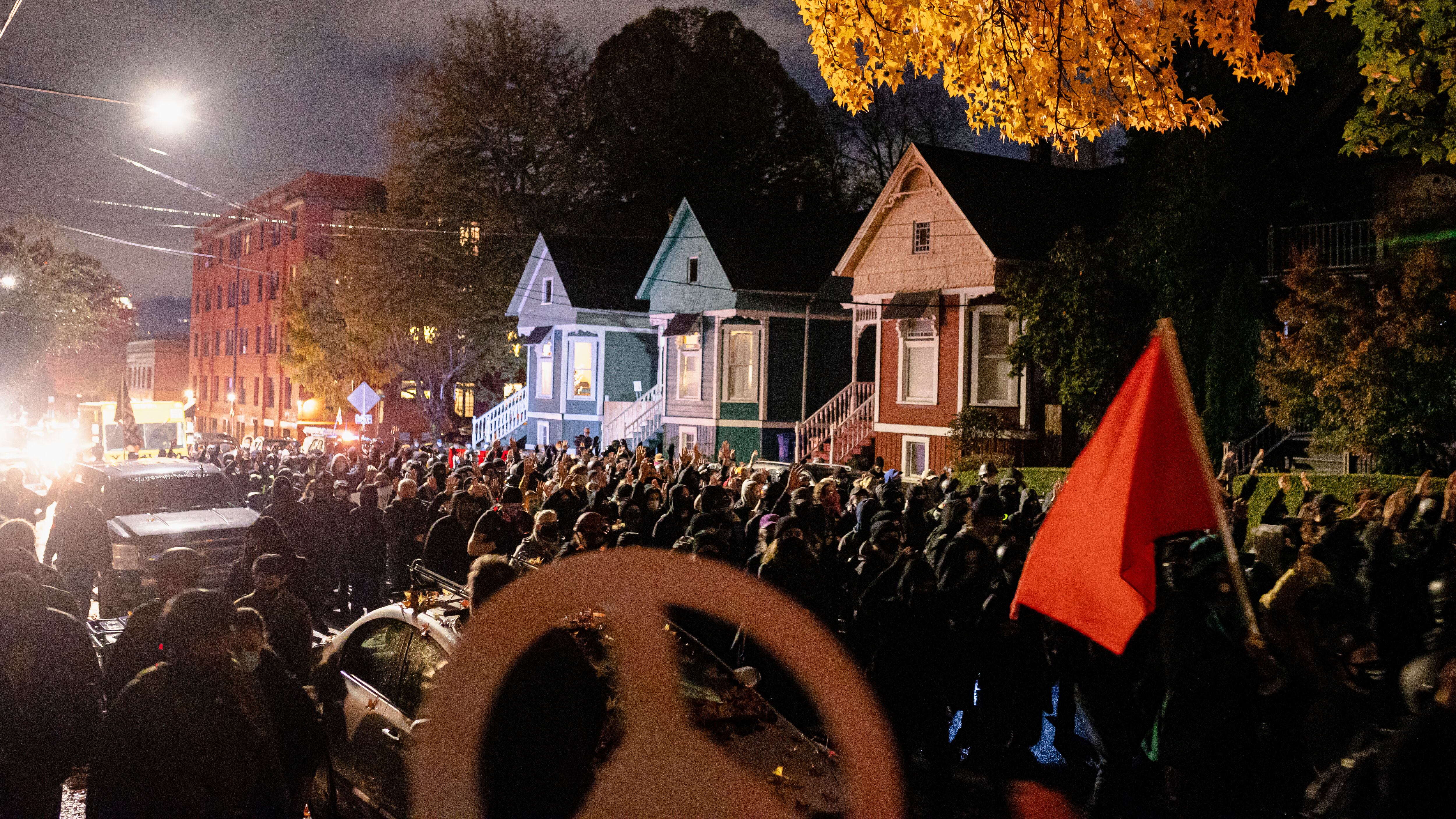Are protest banners weapons? Sometimes, according to the Portland Police Bureau.
A recent investigation by PPB’s internal affairs unit, reviewed by the city’s Independent Police Review, determined that Officer Brent Taylor did not violate bureau directives when he shot five rounds of projectiles at a protester’s legs last June.
The main reason investigators say Taylor acted within policy? Because he believed a banner that protesters carried might conceal or be used as a weapon.
“In the moments prior to deploying his [weapon], Officer Taylor observed protesters utilizing a large banner as what he believed to be a shield,” East Precinct Commander Erica Hurley concluded. “He had concerns the banner could conceal weapons and be used as a weapon.”
The banner was printed with the slogan: “Abolish the PPB.”
IPR Director Ross Caldwell says the city is investigating another case stemming from the same incident. “There is another case related to use of force there,” Caldwell tells WW. “That one is still underway.”
THE DOCUMENT
The City Auditor’s Office sent a letter June 7 to Lester Wrecksie, a protester whom Taylor shot in the legs with a projectile launcher during a June 30, 2020 demonstration outside Portland Police Association headquarters. The letter, obtained exclusively by WW, offers an unusual level of insight into internal affairs investigations, which are typically kept out of public view.
Video from the incident shows police and protesters, including Wrecksie, engaged in a brief tug of war over a white banner, which promptly falls apart when police yank on the white PVC piping that held it together. Within seconds, the video shows, Taylor fired projectiles at Wrecksie, who was wearing roller skates.
Adding this video of Portland police assaulting protesters to the countless others from last night pic.twitter.com/nmQY83N8ka
— Laura Jedeed (@LauraJedeed) July 1, 2020
Wrecksie filed a tort claim notice with the city the following December, which prompted the internal affairs and IPR investigations.
The June 7 letter cited a June 4 memo from internal affairs in which Hurley found that Wrecksie’s complaint against Taylor was “not sustained.” She added that Wrecksie was inadvertently caught in a crossfire between Taylor and several other protesters, and that when police later arrested Wrecksie that same night, “he did not make any complaints of injury or pain.”
IPR deputy director Dana Walton-Macaulay and Lt. Scott Konczal of the IA unit signed off on the letter. Walton-Macaulay wrote that Assistant Chief Michael Leasure and acting Capt. Chris Gjovik also reviewed the incident: “In this case they all agreed with Commander Hurley’s findings.”
THE OFFICER
Taylor, a seven-year veteran of the now-dissolved Rapid Response Team, was a fixture at last summer’s protests. He garnered criticism in activist circles after protesters posted videos of him using what they described as excessive force.
In a March 16, 2021, filing, U.S. District Judge Marco Hernandez ordered Taylor removed from crowd management duty pending the investigations. The Police Bureau says Taylor has not returned to crowd management duties. Taylor did not respond to a request for comment.
THE POLICY DEBATE
While the two agencies that review allegations of officer misconduct found Taylor acted within policy directives, a federal judge disagreed.
Taylor previously made a similar defense of his actions in an earlier federal lawsuit stemming from the Police Bureau’s use of force during protests. In that case, filed in June 2020 by Don’t Shoot PDX, Taylor testified that banners and other protest signs “can be draped across plywood shields reinforced with nails and PVC pipes containing screws or concrete, which could be used as weapons to impale an officer,” according to a November order filed by Judge Hernandez, who summarized Taylor’s testimony.
Taylor further testified that protesters carrying the banner June 30 were slowing police efforts to move the crowd.
“Because of these circumstances, Officer Taylor attempted to take the banner from the protesters,” Hernandez wrote. “Officer Taylor testified that at this moment he suspected that the protester was trying to retain the banner to use it as a weapon.”
Ultimately, however, Hernandez ruled that Taylor’s munition deployment that night did not comply with the Police Bureau’s Use of Force Directive 1010. Taylor’s actions that night had effectively put the city in violation of a temporary restraining order the court issued on June 26, 2020.
“The incident occurred while it was still light out, and video shows that the long PVC banner was flimsy,” Hernandez wrote. He added that Taylor had “ample opportunity” that night to see the banner was not, in fact, a shield and did not conceal weapons.
“At most,” Hernandez wrote, “the record shows that the individual who was refusing to let go of their sign was engaged in passive resistance.”
Update 5:48 pm: This story has been updated with a comment from IPR Director Ross Caldwell.

